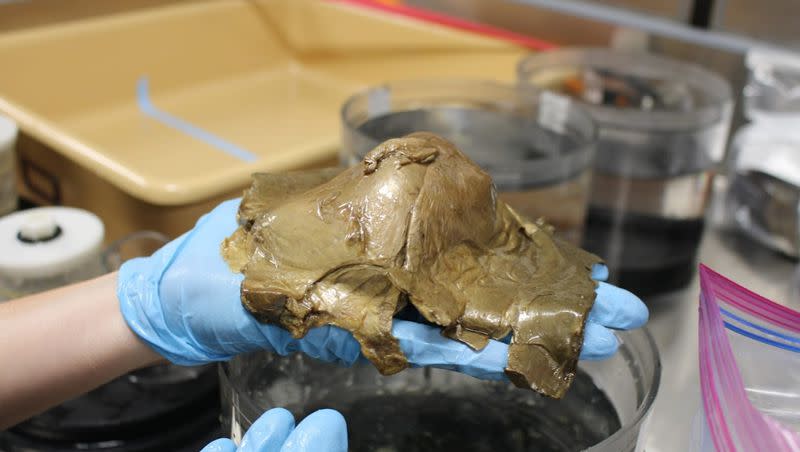Like a ‘horror movie’: NOAA scientists recover mysterious golden orb 2 miles deep off coast of Alaska

Is it coral? A sponge? An egg sac, perhaps? Or the beginning of an “X-Files” episode?
These ideas all arose in recorded commentary from scientists aboard the National Oceanic and Atmospheric Association ship Okeanos Explorer last week as they observed a mysterious “golden orb” attached to a rock outcropping via remote camera some 2 miles below the surface in waters off the coast of Alaska.
NOAA scientist Sam Candio, coordinator for the ongoing Seascape Alaska 5: Gulf of Alaska Remotely Operated Vehicle Exploration and Mapping expedition, said the creature, or remnants of a creature, had been retrieved using a robotic arm and vacuum-powered sample tube and was headed to a lab for further testing.
“Isn’t the deep sea so delightfully strange?” Candio said in a press statement. “While we were able to collect the ‘golden orb’ and bring it onto the ship, we still are not able to identify it beyond the fact that it is biological in origin.
“We likely won’t learn more until we are able to get it into a laboratory setting where we can continue to pull from the collective expertise of the scientific community with more sophisticated tools than we are able to maintain on the ship. While somewhat humbling to be stumped by this finding, it serves as a reminder of how little we know about our own planet and how much is left to learn and appreciate about our ocean.”
NOAA reports the gold, dome-shaped specimen, a little over four inches in diameter, was found adhered to a rock amid a smattering of white sponges at a site 250 miles off the coast of southern Alaska at a depth of 2 miles. A small hole or tear near its base revealed a similarly colored interior, indicating, perhaps, that something had left or entered the fleshy dome.
“I just hope when we poke it, something doesn’t decide to come out,” one scientist can be heard saying on a video recording of the retrieval of the specimen, per the Miami Herald. “It’s like the beginning of a horror movie.”
The discovery was made just a week into NOAA’s Seascape Alaska 5 expedition that launched Aug. 23 and continues through Sept. 16. The primary goal of the research effort is to “map, explore and characterize ecologically and economically important deepwater habitats in unexplored regions off Alaska,” according to NOAA. Operations are focused on exploring deep waters greater than 656 feet for mapping operations and 820 feet for remote operated vehicle operations in U.S. waters, the high seas and Canadian waters off Alaska.
While the intriguing gold orb specimen was found at a depth of about 2 miles, some of the remote dives will descend to nearly 4 miles beneath the surface of the Gulf of Alaska to explore deep-sea coral and sponge habitats, fish habitats, chemosynthetic communities and the water column and to improve knowledge of past and potential geohazards, per NOAA’s mission statement.
NOAA reports that while it’s still unclear if the golden dome is associated with a known species, a new species, or perhaps represents an unknown life stage of an existing one, the discovery highlights the importance of ocean exploration.
“New species have the potential to reveal new sources for medical therapies and vaccines, food, energy, and other societal benefits and knowledge,” Candio said. “Collectively, the data and information gathered during this expedition will help us close gaps in our understanding of this part of the planet, so we can better manage and protect it.”

